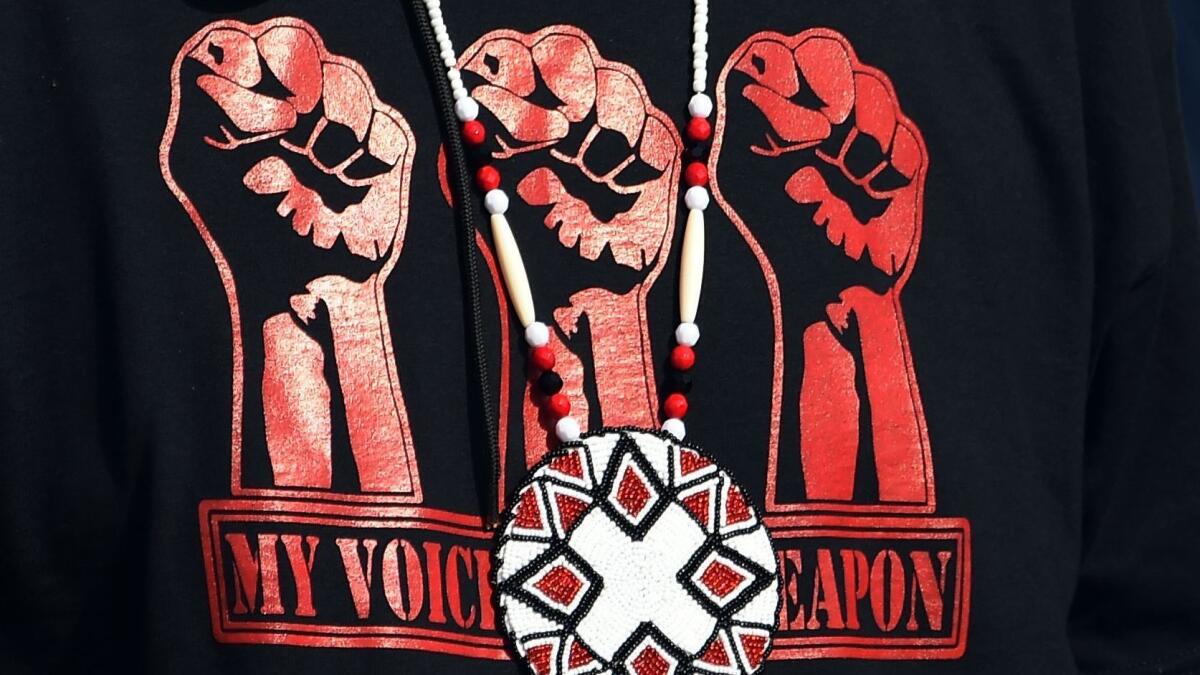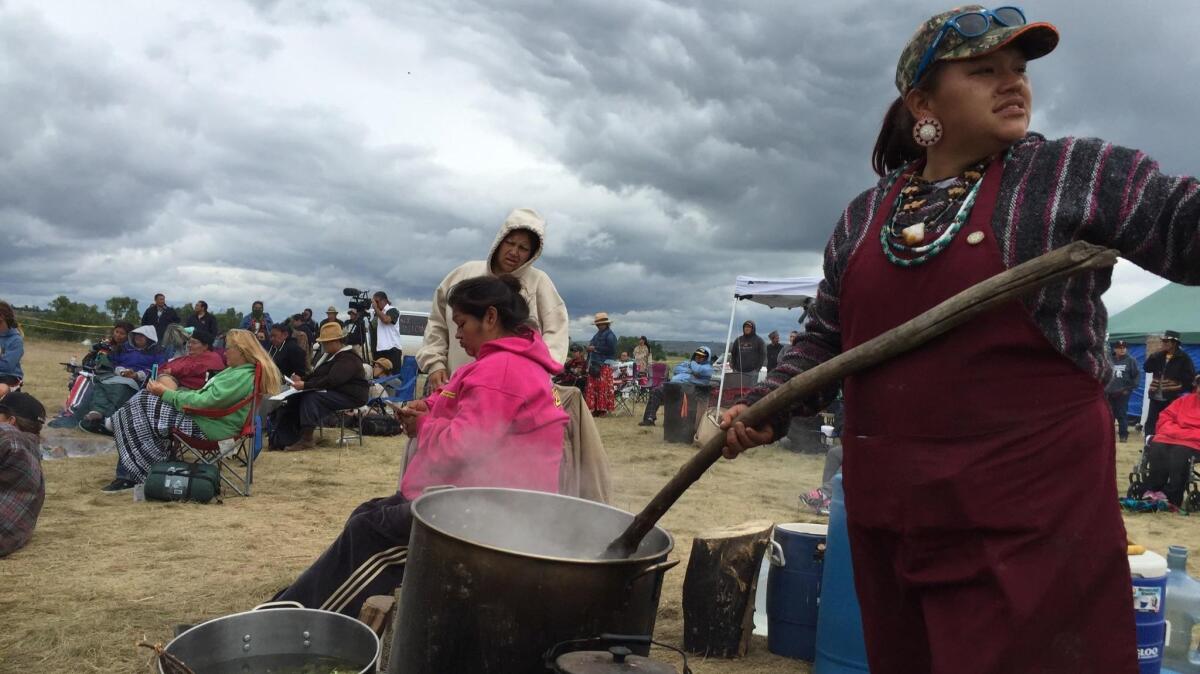How a fight against the ‘black snake’ at Standing Rock formed a global community

Protesters have stood in the path of an oil pipeline that is under construction near the Standing Rock Sioux Reservation, which straddles North and South Dakota.
- Share via
Reporting from Along the Cannon Ball River, N.D. — One snowy afternoon in April, a small group of Native Americans rode on horseback through the Standing Rock Sioux Reservation and set up camp on a windy hillside overlooking the Cannonball River. They erected tepees, foraged for firewood and prayed for allies to help their people fight “the black snake.”
The 1,172-mile, $3.8-billion Dakota Access pipeline, they believed, would threaten their sacred sites and contaminate the Missouri River, the water supply for the Standing Rock tribe and 17 million other Americans.
As spring turned to summer, Native people began arriving from across the Great Plains and from hundreds of other tribal nations in North America. Supporters came from Guatemala, Norway, the Czech Republic, South Africa and the Philippines. There were climate activists, community organizers, pro bono lawyers, human rights delegations, musicians, medics, clergy, journalists, hippies and a few drifters with perhaps nowhere else to go.
By August, more than 6,000 people had created a small city in a flood plain of the Missouri to battle the pipeline, built by the Fortune 500 company Energy Transfer to pump 570,000 barrels of crude oil per day. The “water protectors” called their main camp Oceti Sakowin, or Seven Council Fires, after the tribes of the Great Sioux Nation. There they erected tents and tepees, parked campers and horse trailers, and planted the flags of about 300 tribes, which flap in the wind on the long dirt track called Crazy Horse Avenue.
The Seven Council Fires camp and the adjacent Sacred Stone and Red Warrior camps have become communities of Native American solidarity likely not seen in more than a century. Lakota and Dakota people say these tribes have not joined to face a common enemy since the 1876 defeat of Gen. George Custer in the Battle of the Greasy Grass, better known as Little Big Horn.
“I remember this elder, years ago, he had a dream where there would be a town where it’s all Natives and we would be singing and dancing and laughing and eating and visiting with each other,” said Linda Black Elk, a professor at nearby Sitting Bull College. “And that’s exactly what camp is like.”

::
Phyllis Bald Eagle and her husband, Black Horse, have come to share the old ways their grandparents taught them: How to skin a deer. How to winterize a tepee in the cold plains nights, radiating heat from the center fire through stones, willows and rugs.
Although there’s a whiff of the American Indian Movement’s 1973 Wounded Knee, S.D., insurrection in the air, Standing Rock protesters say they espouse nonviolent resistance.
Yet Black Horse, a Cheyenne River tribal member, Bald Eagle and hundreds of others are making their stand in the face of a militarized force of state and county police and the National Guard, who have used pepper spray, rubber bullets and occasionally Tasers to push back protesters. Since Aug. 10, police have arrested more than 460 water protectors, including 141 one day in October when activists moved their tents and tepees in front of the advancing pipeline, scrawling numbers on their arms, detaining them in large cages and charging them with criminal trespass and rioting.
Darryl Grady was one of them, arrested at a demonstration Oct. 10 when he and other protesters erected a tepee in the pipeline’s path. Two days later, Grady warmed himself by his fire, sitting with his wife, Rochelle, and their two teenage children in the Seven Council Fires camp. He grew up in New Town on the Fort Berthold Reservation, in the heart of the Bakken oil formation and North Dakota’s now-bust fracking industry. Rochelle grew up just to the west, in Williston. They saw the fracking boom bring fleeting wealth to their tribes, but also violent crime and a legacy of inequality.
“I’ve seen the community just bombarded with all the drilling of fracking, the draining of the aquifers, the pollution, the massive influx of people — it was overwhelming,” she said. After the bust, when the couple saw the next oil battle looming, they came to Standing Rock.
Understanding the lessons from past oil development is a common theme here. “They always tell us to trust them; that they have all this smart, intelligent technology,” said Tom Goldtooth, director of the Indigenous Environmental Network. “But we’ve learned from other people, from other pipeline communities, that it’s not if a pipeline is going to spill or leak, it’s when.”
For Goldtooth and others, a larger agenda is playing out along the river.
“The goal is to build sustainable communities,” said Goldtooth, sitting in the cab of his pickup truck late one windy afternoon, looking down from the hillside onto the sun-dappled tepees.
Supporters of the fight here run the gamut of motivations and skill sets. A lawyer with young children at home came from Colorado to co-found the Red Owl Legal Collective, which has posted bond money for those arrested. A volunteer who worked at Tesla brought schematics for innovative solar and other renewable technology. A photographer from Georgia runs the press credentialing center on “Facebook Hill” above the main camp. A medic from Appalachia treats those doused with pepper spray. A group of advocacy journalists called Unicorn Riot posts regular feeds from the front lines on Twitter and Facebook, part of a social media storm that has brought far-flung attention.
On any given day you could encounter two dozen Lutheran ministers chatting with Standing Rock tribal leaders, a Black Lives Matter delegation joining a protest march or a Japanese musician strumming a guitar at a campfire and a college student whose parents don’t know he’s at Standing Rock.

Some come from sheer curiosity and a wish to be part of something, despite being ill-equipped for the raw elements.
“I’ve been traveling for a few months,” said Kendra Strebig, a young white woman from Ohio with dreadlocks to her waist. She arrived clad in Birkenstocks but got wool socks and a winter coat from the piles of donated clothes. Some organizers here are frustrated by the drain on resources, especially from young non-Native visitors; others point out that it is they, as much as anyone, who put their bodies on the line, willing to risk pepper spray, rubber bullets and jail to fight the pipeline.
Now winter is fast approaching, and with it divisions in the camp about how best to consolidate the living space for the hardcore 300 or so determined to endure outdoor living in the northern Plains, where temperatures can drop to 30 below. In nearby Cannon Ball, residents at a recent community meeting worried whether the campers could survive in the cold, and lamented the reports of theft and petty crime in the camp. Others say these are the inevitable growing pains of a freshly rooted community.
Work on the pipeline is nearly finished. Activists here are stepping up pressure on the Obama administration to deny Energy Transfer permission to complete a near-final step: drilling under the Missouri River. Whatever happens, they say, even the election of Donald Trump doesn’t alter their unity of purpose.
“It is absolutely a historic event,” said Black Elk, the Sitting Bull College professor. She regularly puts out the call on social media to recruit new allies to come to Standing Rock, even if it is only “to say to your great-grandchildren, ‘I was there.’
“People from all over the world who have looked out of the corner of their eye and then looked away in shame — they’re not looking away anymore,” Black Elk said. “They’re coming to stand with us.”
Tolan is a special correspondent.
MORE NATIONAL NEWS
Trump names Priebus and Bannon as top White House aides and says deportations will begin immediately
Oregon protester shot during a fourth night of election protests across the nation
Climate change is real: Just ask the Pentagon
More to Read
Sign up for Essential California
The most important California stories and recommendations in your inbox every morning.
You may occasionally receive promotional content from the Los Angeles Times.










